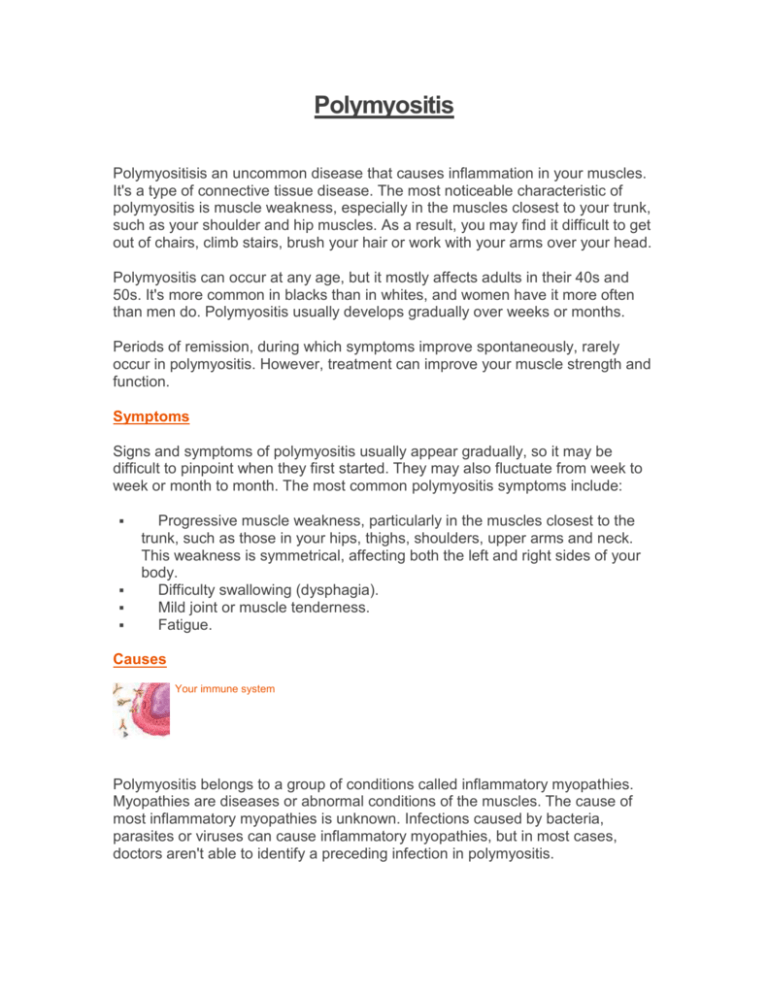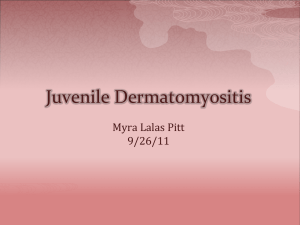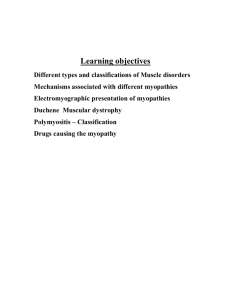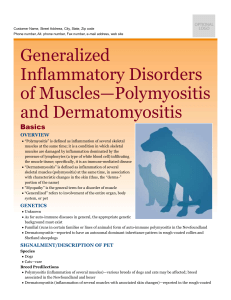Polymyositis
advertisement

Polymyositis Polymyositisis an uncommon disease that causes inflammation in your muscles. It's a type of connective tissue disease. The most noticeable characteristic of polymyositis is muscle weakness, especially in the muscles closest to your trunk, such as your shoulder and hip muscles. As a result, you may find it difficult to get out of chairs, climb stairs, brush your hair or work with your arms over your head. Polymyositis can occur at any age, but it mostly affects adults in their 40s and 50s. It's more common in blacks than in whites, and women have it more often than men do. Polymyositis usually develops gradually over weeks or months. Periods of remission, during which symptoms improve spontaneously, rarely occur in polymyositis. However, treatment can improve your muscle strength and function. Symptoms Signs and symptoms of polymyositis usually appear gradually, so it may be difficult to pinpoint when they first started. They may also fluctuate from week to week or month to month. The most common polymyositis symptoms include: Progressive muscle weakness, particularly in the muscles closest to the trunk, such as those in your hips, thighs, shoulders, upper arms and neck. This weakness is symmetrical, affecting both the left and right sides of your body. Difficulty swallowing (dysphagia). Mild joint or muscle tenderness. Fatigue. Causes Your immune system Polymyositis belongs to a group of conditions called inflammatory myopathies. Myopathies are diseases or abnormal conditions of the muscles. The cause of most inflammatory myopathies is unknown. Infections caused by bacteria, parasites or viruses can cause inflammatory myopathies, but in most cases, doctors aren't able to identify a preceding infection in polymyositis. A disease similar to polymyositis is dermatomyositis. Dermatomyositis leads to many of the same symptoms as polymyositis, but it causes skin inflammation or a rash as well. Some other inflammatory muscle diseases are: inclusion body myositis, which progresses more slowly than other forms; myositis associated with other connective tissue diseases, such as lupus or scleroderma; and myositis associated with cancer. Immune system plays role Doctors suspect that myopathies are autoimmune disorders, in which body's immune system mistakes normal components of body for foreign substances and attacks them. If you have polymyositis, an unknown cause seems to trigger immune system to begin producing autoimmune antibodies (also called autoantibodies) that may damage healthy body tissues. Many people with polymyositis show a detectable level of autoantibodies in their blood. It's still unclear, however, whether these autoantibodies are indeed involved in causing polymyositis. Polymyositis has also been associated with several viral diseases, including HIV. Some researchers speculate that, in some form, polymyositis may be caused by a viral infection of the muscle. This theory isn't well supported,. Tests and diagnosis Diagnosis of polymyositis isn't always easy and can be a lengthy process. Even though the attempt to diagnose your condition may be frustrating, remember that an accurate diagnosis is necessary to receive appropriate treatment. In addition to a thorough physical exam, including assessment of muscle strength, doctor will likely use some or all of the following information and tests to assist in the diagnosis: Family medical history. A careful history of muscle disease in family and age at onset of the disease will help doctor distinguish between polymyositis and muscular dystrophy. Muscular dystrophy is an inherited condition; its signs and symptoms usually begin in early childhood. Electromyography. A thin needle electrode is inserted through skin into the muscle to be tested. Electrical activity is measured as you relax or tighten the muscle. Changes in the pattern of electrical activity can confirm a muscle disease. The distribution of the disease can be determined by testing different muscles. Blood analysis. A blood test can let your doctor know if you have elevated levels of muscle enzymes, such as creatine kinase (CK) and aldolase. Increased CK and aldolase levels can indicate muscle damage. A blood test can also determine whether autoantibodies are present in your blood. In some cases, specific types of autoantibodies have been associated with certain signs or symptoms of the disease, such as skin or lung involvement, and with how the disease responds to treatment. Knowing whether you have these autoantibodies may help doctor determine the best treatment plan. Muscle biopsy. A small piece of muscle tissue is removed surgically for laboratory analysis. A muscle biopsy may reveal abnormalities in muscles, such as inflammation, damage or infection. The sample also can be examined for the presence of abnormal proteins and checked for enzyme deficiencies. Magnetic resonance imaging (MRI). A scanner creates cross-sectional images of muscles from data generated by a powerful magnetic field and radio waves. These images can be viewed from any direction or plane. MRI scans may help detect inflammation in your muscles. Monitoring risk of infections People with polymyositis may also be at an increased risk of infections, particularly respiratory and digestive infections Complications these complications of polymyositis: Difficulty swallowing. If the muscles in esophagus are affected, may have problems swallowing (dysphagia), which in turn may cause weight loss and malnutrition. Aspiration and pneumonia. Difficulty swallowing may also lead to entrance of food or liquids, including saliva, into lungs (aspiration), which can lead to pneumonia. Breathing problems. If your chest muscles are involved, may experience breathing problems, such as shortness of breath. Calcium deposits. Late in the disease, particularly if the disease for a long time, deposits of calcium can occur in muscles, skin and connective tissues (calcinosis). Polymyositis is often associated with other conditions, including: Other connective tissue diseases. Diseases such as lupus, rheumatoid arthritis, scleroderma and Sjogren's syndrome can occur in combination with polymyositis. Cardiovascular disease. The muscle of heart may become inflamed (myocarditis). In a small number of people who have polymyositis, congestive heart failure and heart arrhythmias may develop. Lung disease. A condition called interstitial lung disease may occur with polymyositis. Interstitial lung disease refers to a group of disorders that cause inflammation and scarring (fibrosis) of lung tissue, making lungs stiff and inelastic. Signs and symptoms include a dry cough and shortness of breath. In the late stage of lung disease, high blood pressure in the pulmonary arteries (pulmonary hypertension) can occur and can lead to right-sided heart failure. Cancer. Cancer may be more common in people with polymyositis, but the evidence for this association is more pronounced in dermatomyositis. Concerns during pregnancy Pregnancy may worsen signs and symptoms in women whose disease is active. Active polymyositis can also increase the risk of premature birth or stillbirth. If the disease is in remission, the risk isn't as great Treatments and drugs Although there's no cure for polymyositis, treatment can improve your muscle strength and function. Treatment begun early in the disease process tends to be more effective, often because there are fewer complications. Therapies include the following: Corticosteroids. These medications suppress immune system, limiting the production of antibodies and reducing muscle inflammation. Corticosteroids, especially prednisone, are usually the first choice in treating inflammatory myopathies, such as polymyositis. doctor may begin with a very high dose then decrease it as your symptoms improve. Improvement generally takes about two to four weeks. Significant results are usually evident within three to six months, but therapy is often needed for years. Prolonged use of corticosteroids can have serious side effects including osteoporosis, weight gain, diabetes, increased risk of some infections, mood swings, cataracts, high blood pressure, a redistribution of body fat and muscle weakness. As a result, your doctor may also recommend supplements, such as calcium and vitamin D, and may prescribe bisphosphonates, such as alendronate (Fosamax) or risedronate (Actonel), to counteract loss of bone density. Other immunosuppressants. If your body doesn't respond adequately to corticosteroids, your doctor may recommend other immunosuppressive drugs, such as azathioprine (Imuran) or methotrexate (Rheumatrex). Your doctor may prescribe these alone or in combination with corticosteroids. When in combination, these additional immunosuppressants can be used to lessen the dose and potential side effects of the corticosteroid. Immunosuppressants, such as cyclophosphamide (Cytoxan) and cyclosporine (Neoral, Sandimmune), may improve symptoms of polymyositis and interstitial lung disease. Physical therapy. A physical therapist can show various exercises to maintain and improve your strength and flexibility and advise an appropriate level of activity. Your exercise program is likely to change during the course of the disease and treatment period. Staying active will help maintain muscle strength. Polymyositis treatments that are still under investigation include: Plasmapheresis. This treatment, also called plasma exchange, is a type of blood cleansing in which damaging antibodies are removed from your blood. Radiation therapy. This involves irradiation of the lymph nodes to suppress your immune system. Intravenous immunoglobulin (IVIg). This involves receiving intravenous infusions of antibodies from a group of donors over two to five days. This treatment is usually expensive. It may be an option for you if your dermatomyositis is severe or resistant to other forms of therapy. Fludarabine (Fludara). This agent prevents the development and growth of malignant cells. Tacrolimus (Prograf). This transplant-rejection drug may work to inhibit the immune system. Tacrolimus is often used topically to treat dermatomyositis and other skin problems. Monoclonal antibodies. These man-made antibodies are designed to target and destroy specific types of cells. infliximab (Remicade) and rituximab (Rituxan) on both polymyositis and dermatomyositis Dermatomyositis Dermatomyositisis an uncommon disease marked by muscle weakness and a distinctive skin rash. It's a type of inflammatory muscle disease — "myo" means "muscles" in Greek; "itis" means "inflamed." "Derma," which means "skin," refers to the skin-related symptoms that accompany the muscle inflammation of dermatomyositis. Dermatomyositis may occur at any age, but it mostly affects adults in their late 40s to early 60s or children between 5 and 15 years of age. Women have dermatomyositis more often than men do. Dermatomyositis usually develops over weeks or months. Periods of remission, when symptoms of dermatomyositis improve spontaneously, may occur. Treatments can improve your skin and your muscle strength and function. Symptoms The most common signs and symptoms of dermatomyositis include: A violet-colored or dusky red rash, most commonly on your face, eyelids, and areas around your nails, knuckles, elbows, knees, chest and back. Affected areas are typically more sensitive to sun exposure. Progressive muscle weakness, particularly in the muscles closest to the trunk, such as those in your hips, thighs, shoulders, upper arms and neck. This weakness is symmetrical, affecting both the left and right sides of your body. Other dermatomyositis symptoms that may occur include: Difficulty swallowing (dysphagia) Muscle pain or tenderness Fatigue, fever and weight loss Hardened deposits of calcium under the skin (calcinosis), especially in children Gastrointestinal ulcers and infections, also more common in children Lung problems The skin rash usually occurs at the same time as muscle weakness, but may precede muscle weakness by a few weeks. Sometimes, the skin rash alone determines the diagnosis. In some children with dermatomyositis, the skin may become thick and hard in a way similar to scleroderma. When this happens, the condition is called sclerodermatomyositis. Weakness in muscles, such as your hips and shoulders, can lead to difficulty in getting out of chairs, climbing stairs, brushing your hair or working with your arms over your head. Weakness in your neck muscles can make it hard to hold your head up. Causes Your immune system Dermatomyositis belongs to a group of conditions called inflammatory myopathies. Myopathies are diseases or abnormal conditions of the muscles. The cause of most inflammatory myopathies is unknown. One of these diseases that's similar to dermatomyositis is polymyositis. Polymyositis leads to many of the same symptoms as dermatomyositis, but does not cause skin inflammation or a rash. Some other inflammatory muscle diseases are: inclusion body myositis, which progresses more slowly than other forms; myositis associated with other connective tissue diseases, such as lupus or scleroderma; and myositis associated with cancer (malignancy). Immune system plays role Doctors suspect that inflammatory myopathies are autoimmune disorders, in which immune system attacks normal body components. Infections caused by bacteria, parasites or viruses can cause inflammatory myopathies, but in most cases, doctors aren't able to identify a preceding infection in dermatomyositis. Some doctors think certain people may have a genetic susceptibility to the disease. Typically, immune system works to protect your healthy cells from attacks by foreign substances, such as bacteria and viruses. If you have dermatomyositis, an unknown cause seems to trigger immune system to begin producing autoimmune antibodies (also called autoantibodies) that attack your body's own tissues. Small blood vessels in muscular tissue appear to be particularly affected. Inflammatory cells surround the blood vessels and eventually lead to degeneration of muscle fibers. Many people with dermatomyositis show a detectable level of autoantibodies in their blood Tests and diagnosis Dermatomyositis is the most easily recognized of the inflammatory muscle diseases because of its characteristic rash. Occasionally, a rash alone may prompt a diagnosis of dermatomyositis without muscle involvement (amyopathic dermatomyositis). In addition to a thorough evaluation, including examination of muscle strength and a detailed family medical history, doctor may use some or all of the following tests to assist in the diagnosis: Electromyography. A doctor with specialized training inserts a thin needle electrode through the skin into the muscle to be tested. Electrical activity is measured as you relax or tighten the muscle. Changes in the pattern of electrical activity can confirm a muscle disease. The doctor can determine the distribution of the disease by testing different muscles. Blood analysis. A blood test will let your doctor know if you have elevated levels of muscle enzymes, such as creatine kinase (CK) and aldolase. Increased CK and aldolase levels can indicate muscle damage. A blood test can also determine whether autoantibodies are present in your blood. In some cases, specific types of autoantibodies have been associated with certain signs or symptoms of the disease, such as skin or lung involvement, and with how the disease responds to treatment. Knowing whether you have these autoantibodies may help your doctor determine the best treatment plan for you. Muscle biopsy. A small piece of muscle tissue is removed surgically for laboratory analysis. A muscle biopsy may reveal abnormalities in your muscles, such as inflammation, damage or infection. The tissue sample can also be examined for the presence of abnormal proteins and checked for enzyme deficiencies. Skin biopsy. A small piece of skin is removed for laboratory analysis. The skin sample can confirm the diagnosis of dermatomyositis and rule out other disorders, such as lupus. If the skin biopsy confirms the diagnosis, a muscle biopsy may not be necessary. Magnetic resonance imaging (MRI). A scanner creates cross-sectional images of your muscles from data generated by a powerful magnetic field and radio waves. These images can be viewed from any direction or plane. MRI scans may help detect inflammation in your muscles. Complications You may experience these complications of dermatomyositis: Difficulty swallowing. If the muscles in esophagus are affected, you may have problems swallowing (dysphagia), which in turn may cause weight loss and malnutrition. Aspiration and pneumonia. Difficulty swallowing may also lead to entrance of food or liquids, including saliva, into your lungs (aspiration), which can lead to pneumonia. Breathing problems. If your chest muscles are involved, you may experience breathing problems, such as shortness of breath. Gastrointestinal problems. Gastrointestinal ulceration and bleeding can occur. Calcium deposits. Late in the disease, particularly if you've had the disease for a long time, deposits of calcium can occur in your muscles, skin and connective tissues (calcinosis). Dermatomyositis may be associated with other conditions, including: Raynaud's phenomenon. This is a condition in which your fingers, toes, cheeks, nose and ears turn pale when exposed to cold temperatures. Other connective tissue diseases. Diseases affecting tissues that hold your body together, such as your muscles and joints, sometimes occur in conjunction with each other. Conditions such as lupus, rheumatoid arthritis, scleroderma and Sjogren's syndrome can occur in combination with dermatomyositis. Cardiovascular disease. The muscle of your heart may become inflamed (myocarditis). In a small number of people who have dermatomyositis, congestive heart failure and heart arrhythmias may develop. Lung disease. A condition called interstitial lung disease may occur with dermatomyositis. Interstitial lung disease refers to a group of disorders that cause scarring (fibrosis) of lung tissue, making lungs stiff and inelastic. Signs and symptoms include a dry cough and shortness of breath. Cancer. Dermatomyositis in adults has been linked to an increased likelihood of cancer, particularly of the lungs, breasts, ovaries and gastrointestinal tract. Risk of cancer increases with age, although it appears to level off three years after a diagnosis of dermatomyositis. Treatments and drugs There's no cure for dermatomyositis, but treatment can improve your skin, muscle strength and function. Treatment begun early in the disease process tends to be more effective, often because there are fewer complications. Therapies include the following: Corticosteroids. These medications suppress your immune system, limiting the production of antibodies and reducing skin and muscle inflammation. Corticosteroids, especially prednisone, are usually the first choice in treating inflammatory myopathies, such as dermatomyositis. Your doctor may start with a very high dose, and then decrease it as your signs and symptoms improve. Improvement generally takes about two to four weeks. Your doctor may also prescribe topical corticosteroids for your skin. Visible results are usually evident within three to six months, but therapy is often needed for years. Prolonged use of corticosteroids can have serious side effects including osteoporosis, weight gain, diabetes, increased risk of some infections, mood swings, cataracts, high blood pressure, a redistribution of body fat and muscle weakness. As a result, your doctor may recommend supplements, such as calcium and vitamin D, and may prescribe bisphosphonates, such as alendronate (Fosamax) or risedronate (Actonel). Immunosuppressants. If your body doesn't respond adequately to corticosteroids, your doctor may recommend other immunosuppressive drugs, such as azathioprine (Imuran) or methotrexate (Rheumatrex). Your doctor may prescribe these alone or in combination with corticosteroids. When in combination, these additional immunosuppressants can be used to lessen the dose and potential side effects of the corticosteroid. Immunosuppressants such as cyclophosphamide (Cytoxan) and cyclosporine (Neoral, Sandimmune) may improve signs and symptoms of dermatomyositis and interstitial lung disease. Antimalarial medications. For a persistent rash, your doctor may prescribe an antimalarial medication, such as hydroxychloroquine (Plaquenil) or chloroquine phosphate (Aralen). Physical therapy. A physical therapist can show you exercises to maintain and improve your strength and flexibility and advise an appropriate level of activity. Your exercise program is likely to change during the course of the disease and treatment period. Keeping active in general and pacing yourself will help maintain muscle strength. Surgery. Surgery may be an option to remove painful calcium deposits. Pain relievers. Over-the-counter drugs such as aspirin, ibuprofen (Advil, Motrin, others) and acetaminophen (Tylenol, others), can be used to treat any accompanying pain. If these aren't sufficient, your doctor may prescribe a stronger pain reliever, such as codeine. Dermatomyositis treatments that are still under investigation include: Plasmapheresis. This treatment, also called plasma exchange, is a type of blood cleansing in which damaging antibodies are removed from your blood. Radiation therapy. This involves irradiation of the lymph nodes to suppress your immune system. Intravenous immunoglobulin (IVIg Fludarabine (Fludara). This agent prevents the development and growth of malignant cells. Tacrolimus (Prograf). This transplant-rejection drug may work to inhibit the immune system. Monoclonal antibodies. These man-made antibodies are designed to target and destroy specific types of cells







